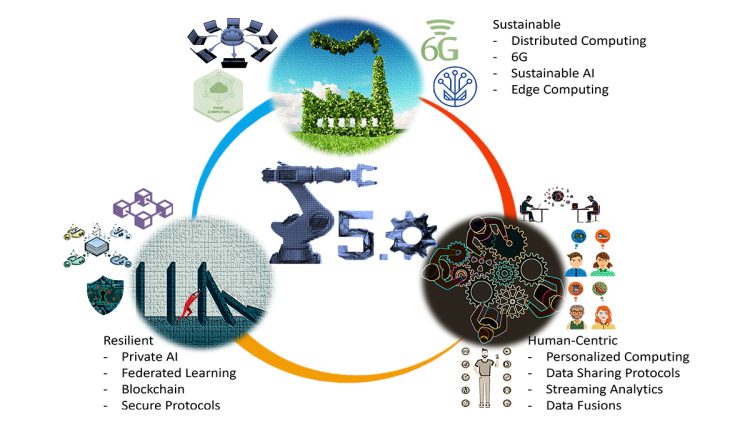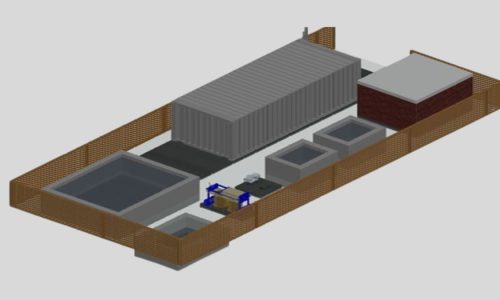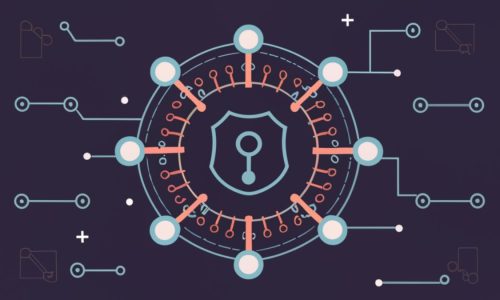Transition Towards Industry 5.0: The world is experiencing the fourth industrial revolution, or Industry 4.0, one of the future projects that the German government outlined in its 2010 ”High-Tech Strategy 2020” action plan. The end goal was to enhance digitization in smart production and bring automated control under the vision of mass production, like in the preceding three industrial revolutions. However, one of the key differences among different revolutions lies in utilizing the state-of-the-art enabling technologies of the respective age (as illustrated in Fig. 2), e.g., the introduction of diverse ICT technologies facilitates the migration from electronics-based Industry 3.0 to the vision of Industry 4.0. Hence, the digitized revolution of Industry 4.0 reshapes today’s industries by increasing the efficiency and intelligence in manufacturing and automation processes.
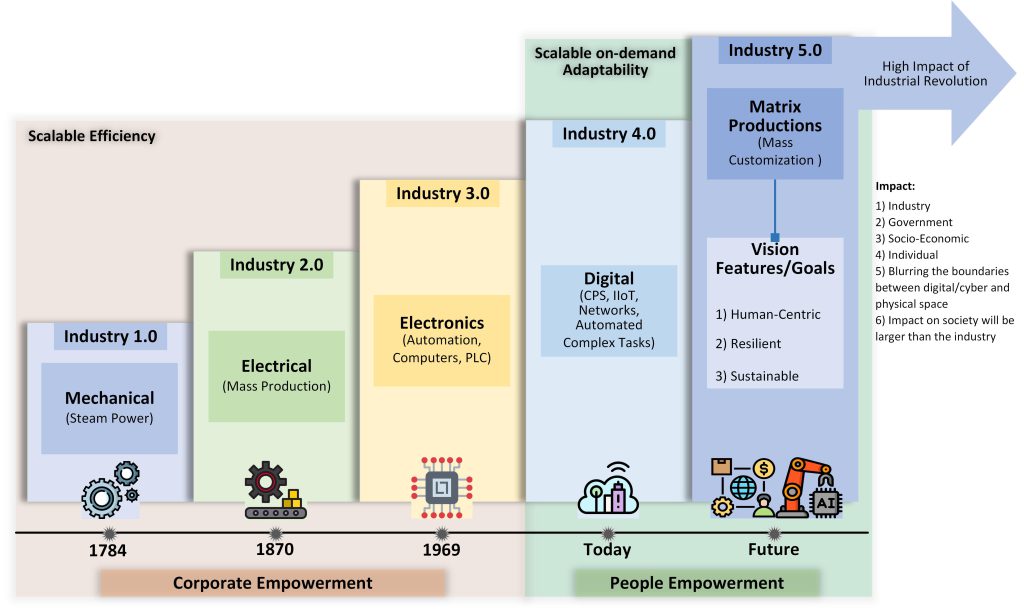
Industry 5.0 Vision: Lately, academia and researchers have started to discuss the futuristic vision for the next industrial evolution or Industry 5.0 vision—an evolution and logical continuation that complements the existing Industry 4.0 paradigm. It envisions the new goals of resilient (increase in industrial production while reducing the disruptions and times of crisis), sustainable (environmental factors, such as energy reduction and reuse of the available resources), and human-centric approaches (human interests and needs at the core of the production process, including personalization and machine interaction) in diverse emerging applications, e.g., factories-of-the-future, digital society. The vision seeks to leverage human intelligence and creativity in nexus with intelligent, efficient, and reliable cognitive collaborating robots (cobots) to achieve zero waste, zero-defect, and mass customization-based manufacturing solutions.
Vision Requirements: A thorough study in Ref. [1] has been conducted in collaboration with our partners from Sweden, South Korea, and UAE to identify and document the enabling industrial applications requirements. The vision requires the merging of cyber-physical worlds (Fig. 1) through utilizing Industry 5.0 technological enablers, e.g., cognitive cobots, person-centric artificial intelligence (AI), cyber-physical systems (CPS), digital twins, industrial internet-of-things (IIoT), hyperconverged data storage and computing, communication infrastructure, and others. In this regard, intelligent next-generation wireless networks (NGWNs) can fulfill the stringent communication and computation requirements of the technological enablers in the industry 5.0 vision.
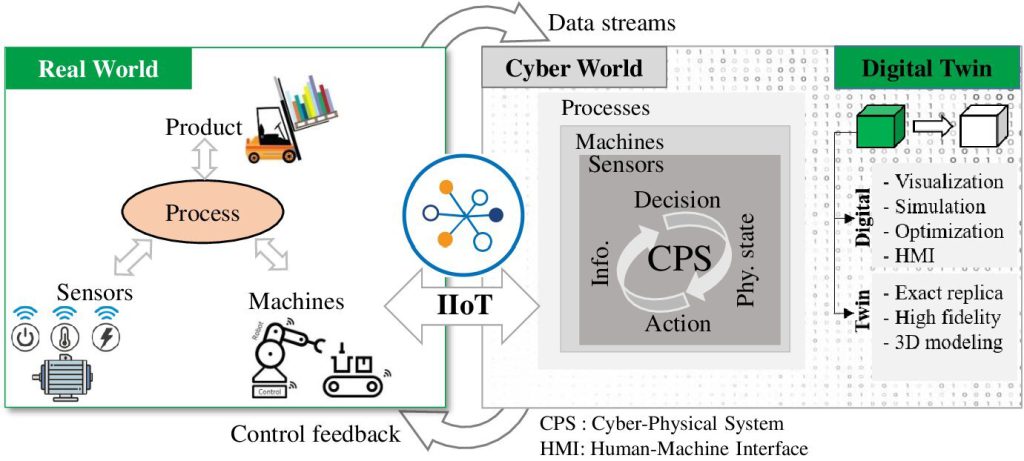
Intelligent NextG Wireless Networks (NGWNs): Intelligent, resilient, and reliable next-generation–or NextG–wireless networks (NGWNs) are envisioned to form a technological enabler for meeting the diverse communication and computation requirements of Industry 5.0 applications and services. Lately, with the deployment of 5G networks, a broad spectrum of research is being carried out to envision next-generation wireless networks or 6G wireless systems— closely integrating the omnipresent AI into every aspect of networking systems to enable hyper-flexible intelligent end-to-end (E2E) networking architecture Ref. [2]. Primary goals include the 1. AI-native service-oriented architecture that possesses the inherent features of flexible and enhanced hybrid 6G services, e.g., ultra-reliable and low latency communication for mission critical applications (remote health surgeries, virtual reality applications), massive connectivity services (smart city applications), 2. high data-transportation and computation networks, and 3. support for knowledgeable and autonomous human-centric systems.
Industry 5.0 and Intelligent NextG Wireless Networks (NGWNs): The fifth industrial revolution powered by enabling communication and computation technologies paves the way for new opportunities for firms to create value for their customers. In this respect, NGWNs unlock new business model opportunities for firms to create and capture value from new enabling technologies. However, it requires all actors (e.g., leading telecom and vertical industries) to collaborate towards realizing the economic impact that would give everyone involved a fair return on their investments. Furthermore, understanding customer needs (i.e., connectivity requirements) is a prerequisite to understanding successful value creation and capturing. Therefore, the real value of NGWNs is defined by improving the manufacturing processes in terms of their responsiveness to the demand, efficiency, capacity utilization, and product/service customization and innovation requirements in Industry 5.0. In this sense, it requires the human- and value-centric design of NGWNs through verticals-technology joint design to enable the actual realization and adaptation of Industry 5.0 goals.
In our research group “Information processing and Transmission (IPT) Lab”, we are actively into the enabling aspects of NGWNs to meet the communication and computation requirements of new vertical applications. For example, in Ref. [3], we performed a realistic performance analysis of enhanced ranging (centimetric positioning accuracies) and communication (high date rate in order of 10-500 Gbps) services simultaneously to industrial devices that are deployed in factory environment having harsh wireless propagation conditions. This work has been done in collaboration with Sweden and UAE. Similarly, in Ref. [4], we deployed a potential proposed solution to approaching the zero-touch intelligent network challenges by adopting edge intelligence or edge-native AI framework design that integrates AI models, state-of-the-art communication networks, and cloud-native edge computing design to accurately predict traffic flows. In this work, we propose a novel idea of an edge intelligence method for analyzing and predicting network data traffic at edge devices according to the emerging 6G vision of softwarized networks. For this purpose, we utilize the testbeds resources of cloud-native enabled OpenFlow over Trans-Eurasia Information Network (OF@TIEN++) Playground, a multisite cloud connecting ten sites in nine Asian countries over TEIN network. Our result accurately predicts the statistical characteristics of data traffic and verifies the trained model against the ground truth network traffic observations. This work has been done in collaboration with Sweden and South Korea.
References:
[1] Shah Zeb, A Mahmood, Syed Ali Hassan, MDJ Piran, M Gidlund, M Guizani, “Industrial digital twins at the nexus of nextG wireless networks and computational intelligence: A survey”, in Journal of Network and Computer Applications (IF=7.5), 2022. DOI: 10.1016/j.jnca.2021.103309
[2] A Mahmood, L Beltramelli, SF Abedin, Shah Zeb, NI Mowla, Syed Ali Hassan, E Sisinni, M Gidlund, “Industrial IoT in 5G-and-Beyond Networks: Vision, Architecture, and Design Trends”, in IEEE Transactions on Industrial Informatics (IF=11.6), 2022. DOI: 10.1109/TII.2021.3115697
[3] Shah Zeb, A Mahmood, Syed Ali Hassan, M Gidlund, M Guizani, “Analysis of Beyond 5G Integrated Communication and Ranging Services under Indoor 3D mmWave Stochastic Channels”, in IEEE Transactions on Industrial Informatics (IF=11.6), 2022. DOI: 10.1109/TII.2022.3146166
[4] Shah Zeb, MA Rathore, A Mahmood, Syed Ali Hassan, JW Kim, M Gidlund, “Edge Intelligence in Softwarized 6G: Deep learning-enabled Network Traffic Predictions”, in IEEE GLOBECOM, Dec 2021, pp. 1-6, Madrid, Spain.
DOI: 10.1109/GCWkshps52748.2021.9682131
The author is a Professor in the Electrical Engineering Department at School of Electrical Engineering and Computer Science, National University of Sciences and Technology (NUST). He can be reached at [email protected].
Research Profile: https://bit.ly/3ZwLp20


